







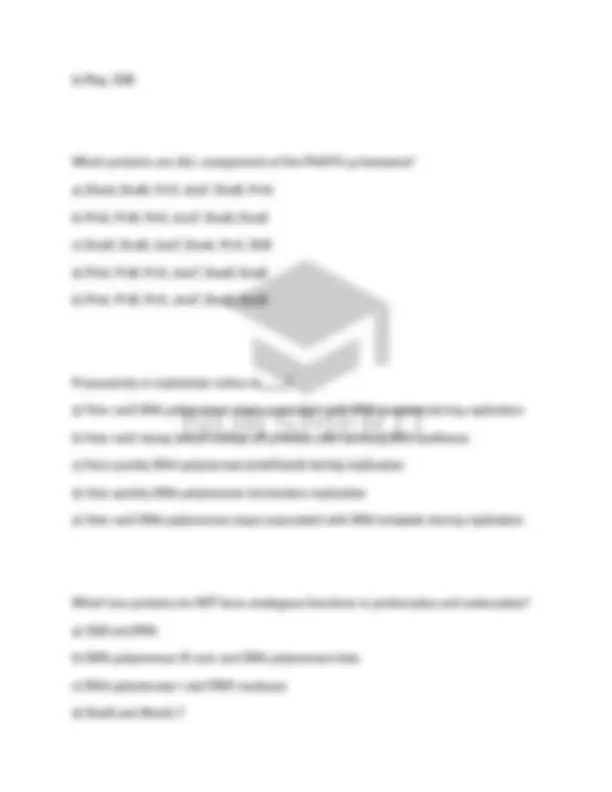
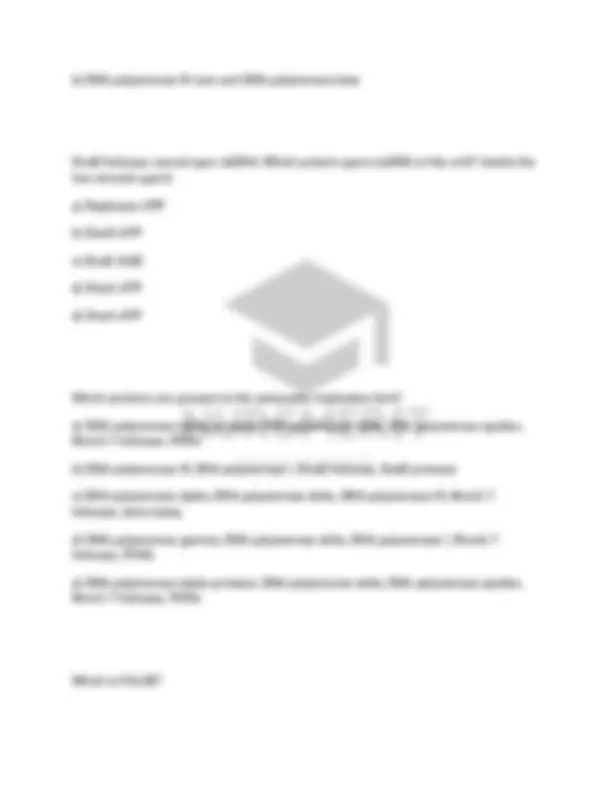
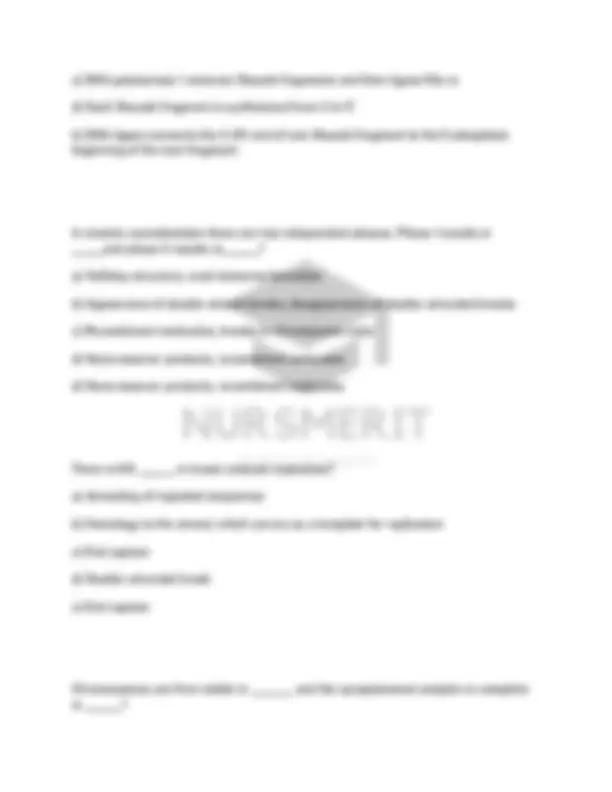
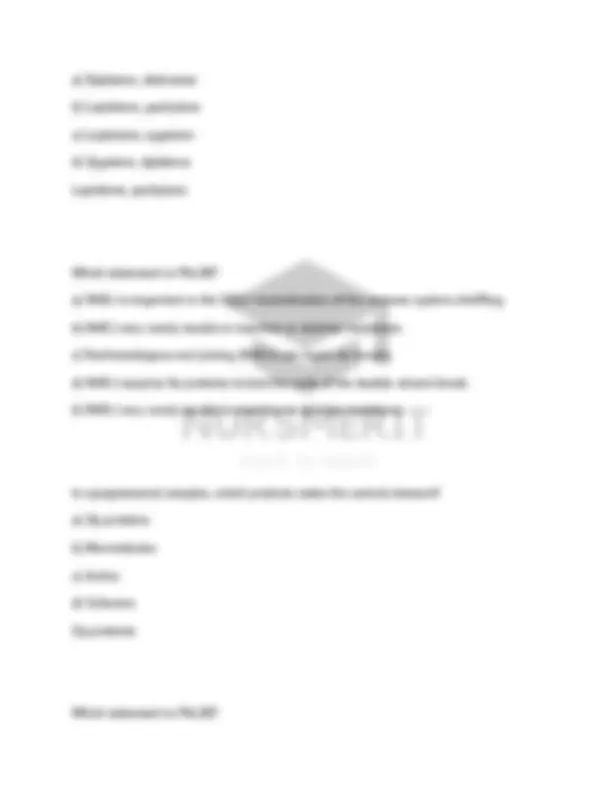
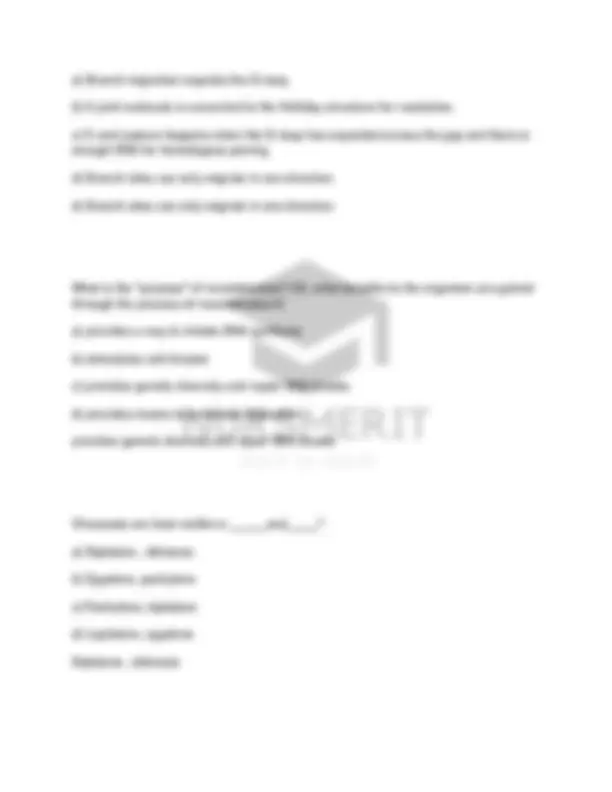
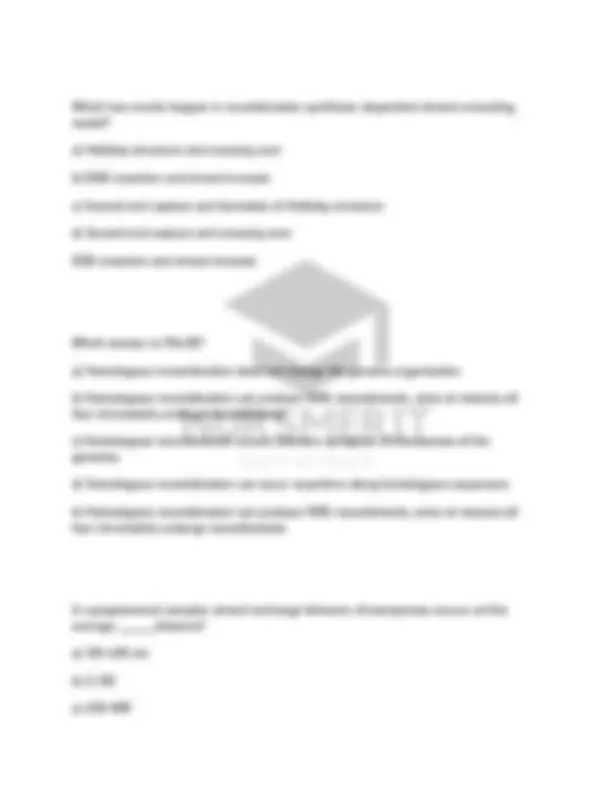
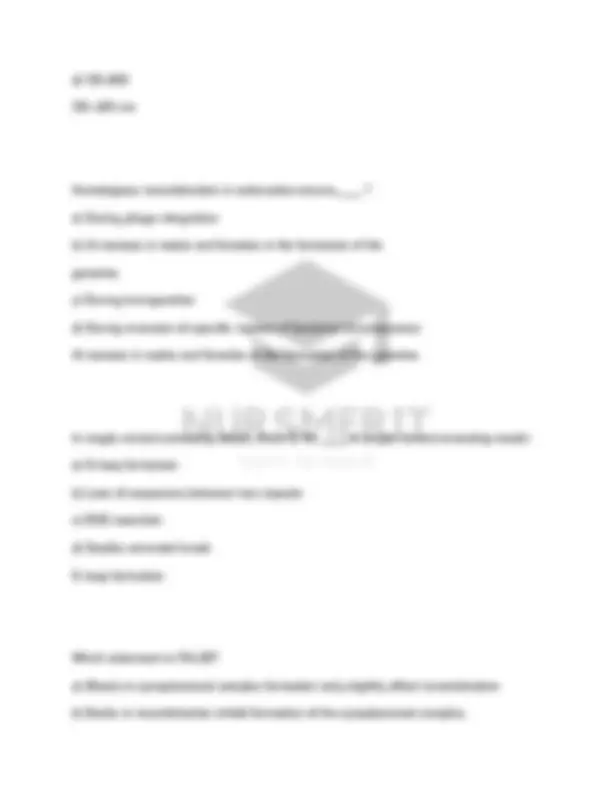
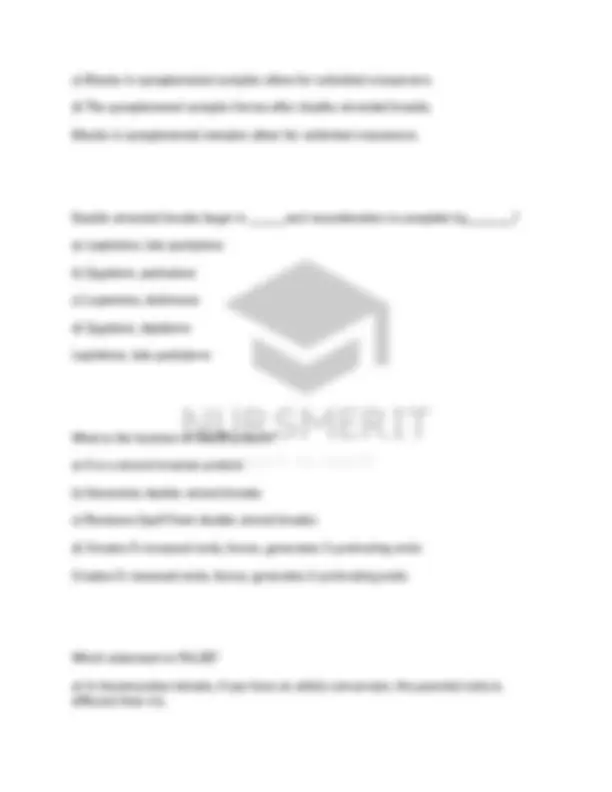
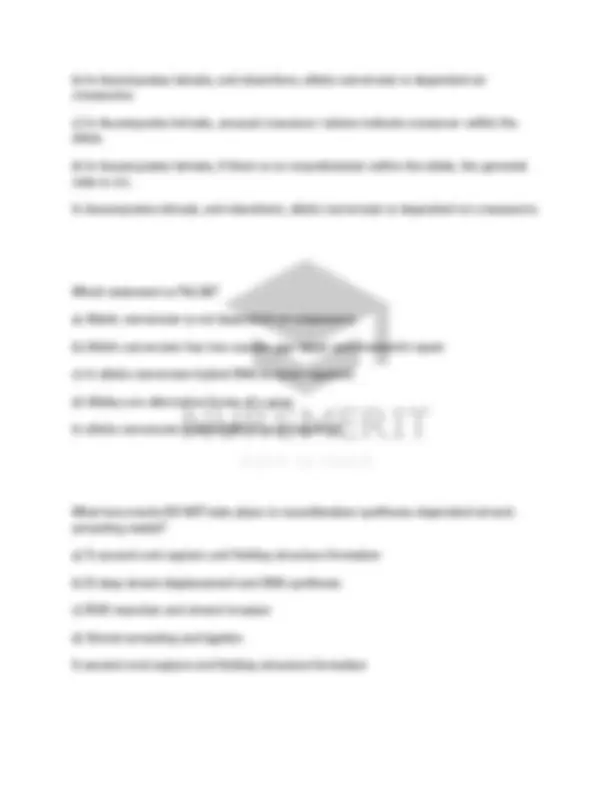



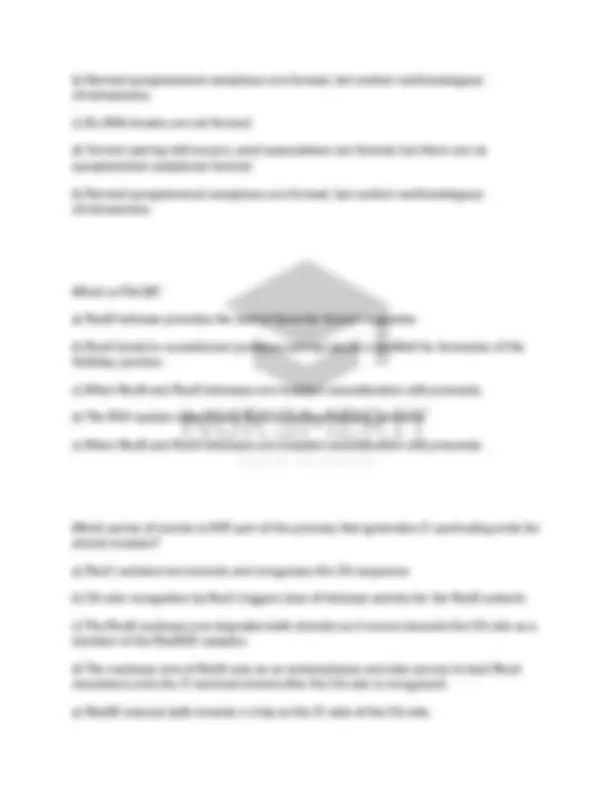

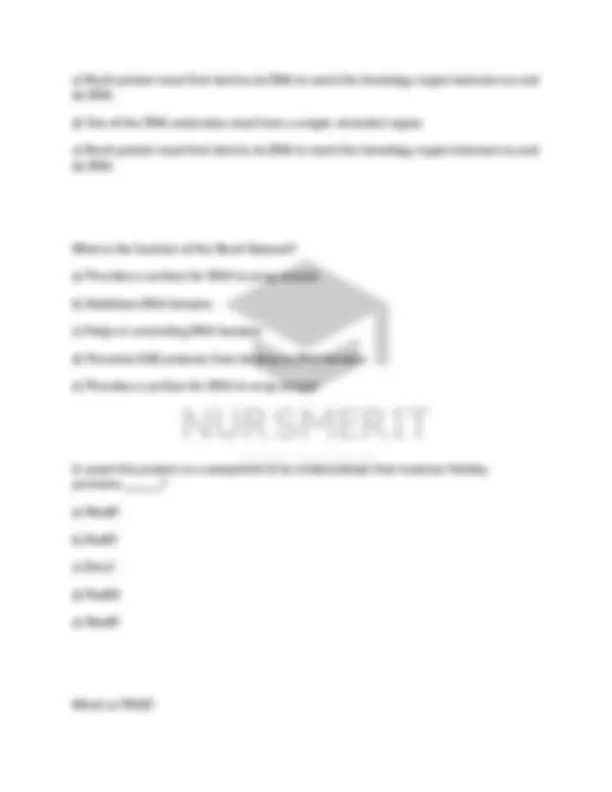


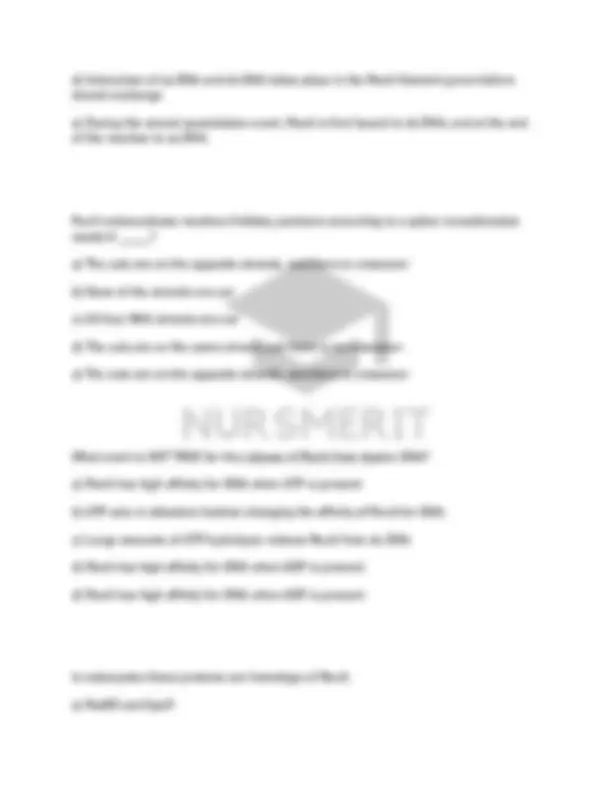

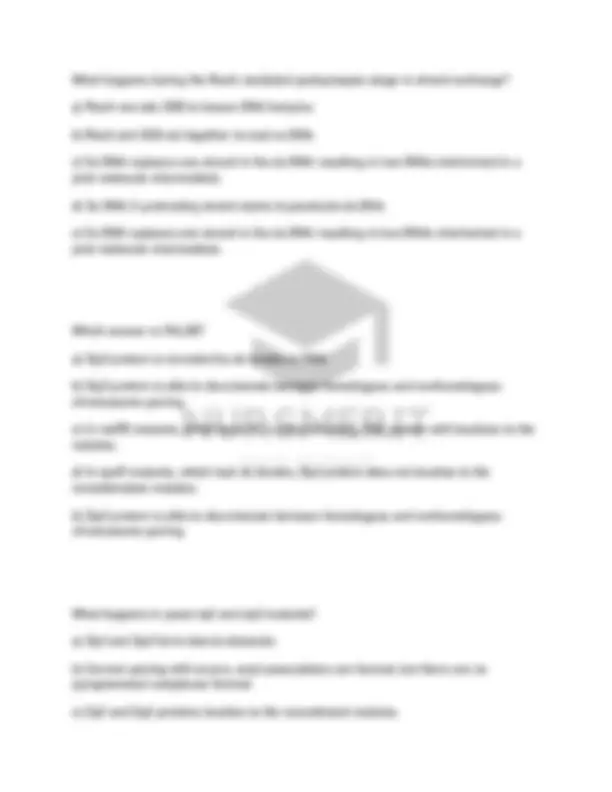
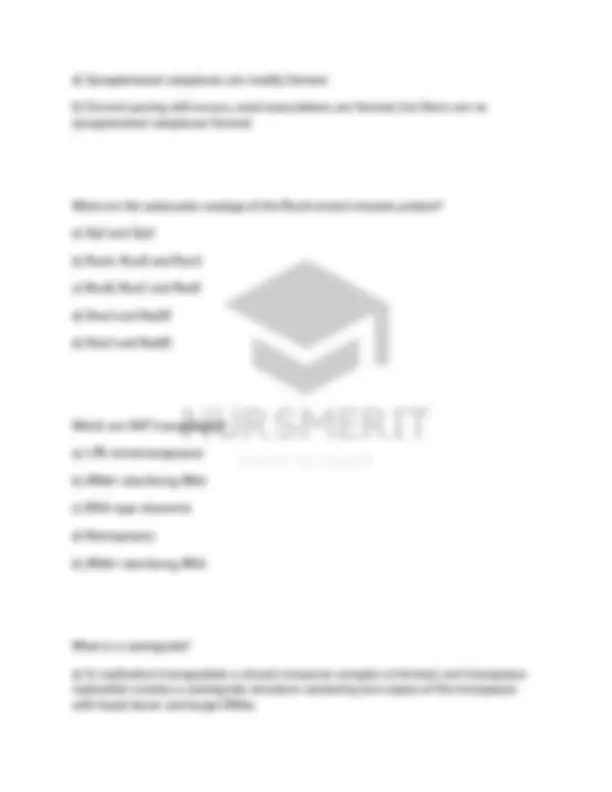
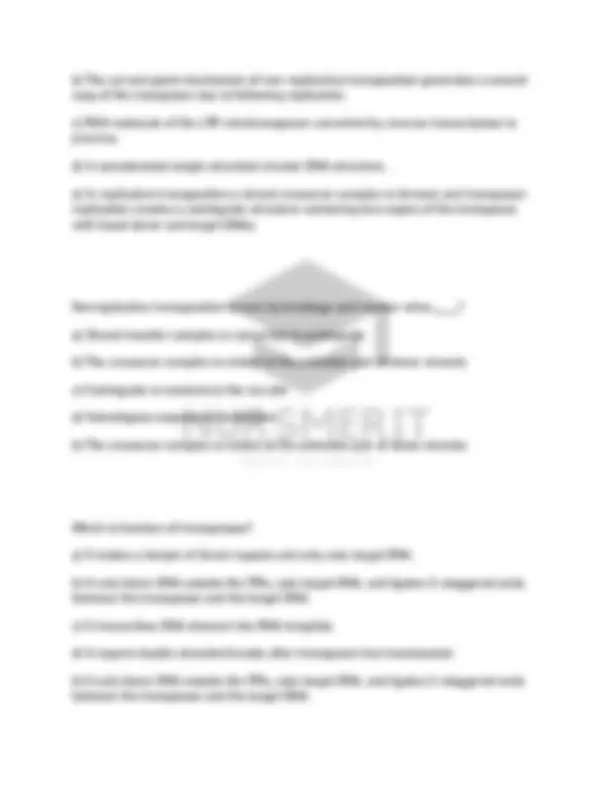
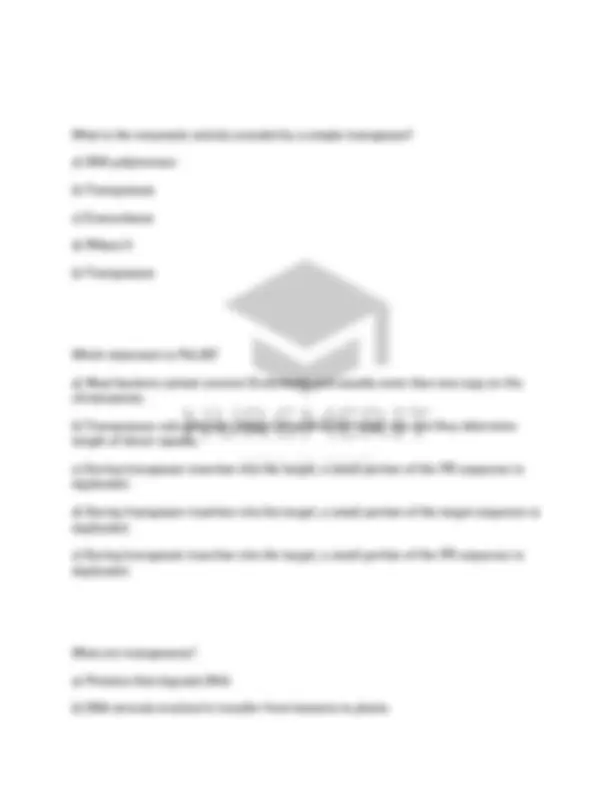
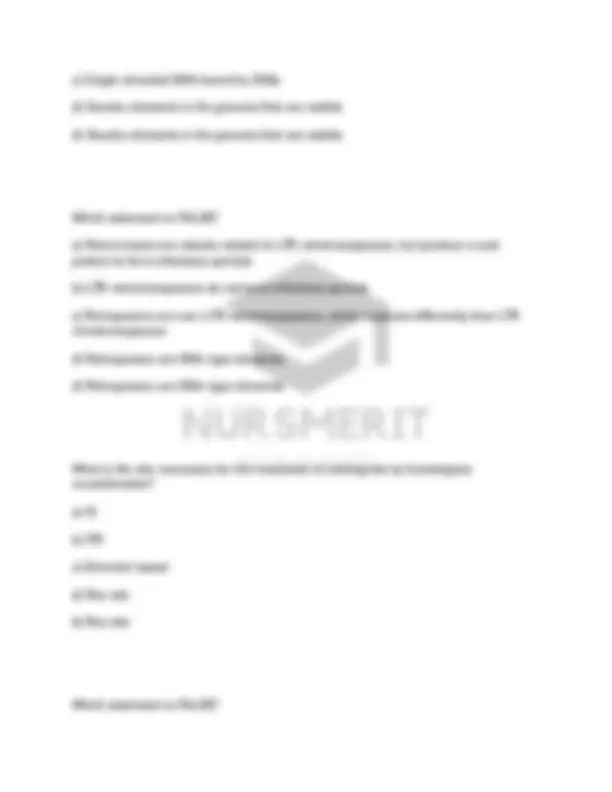



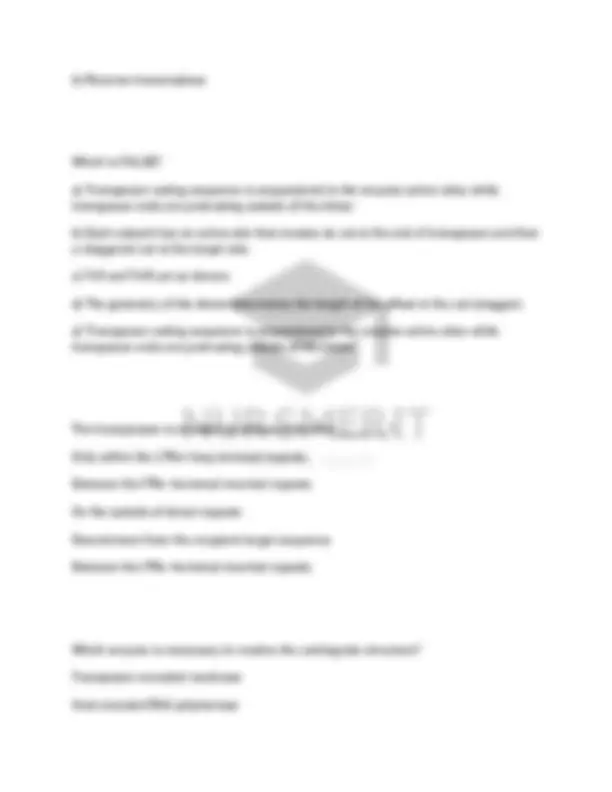

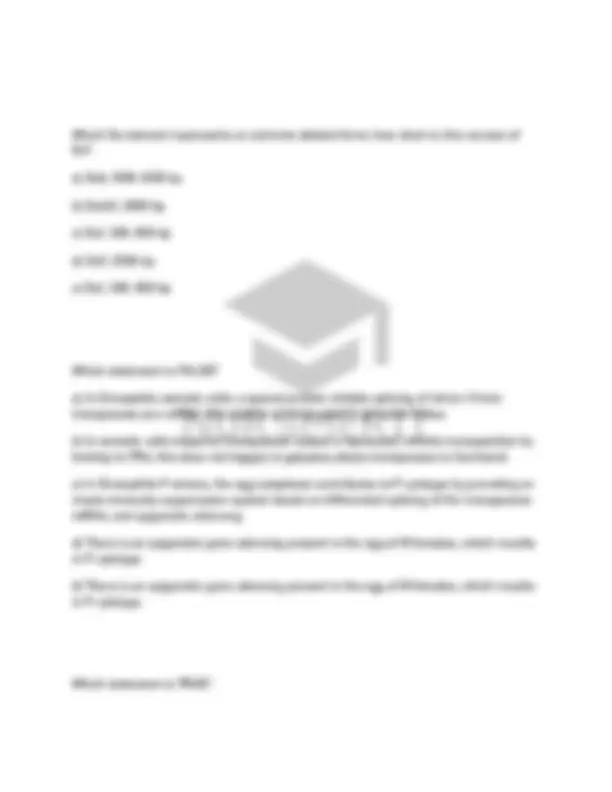
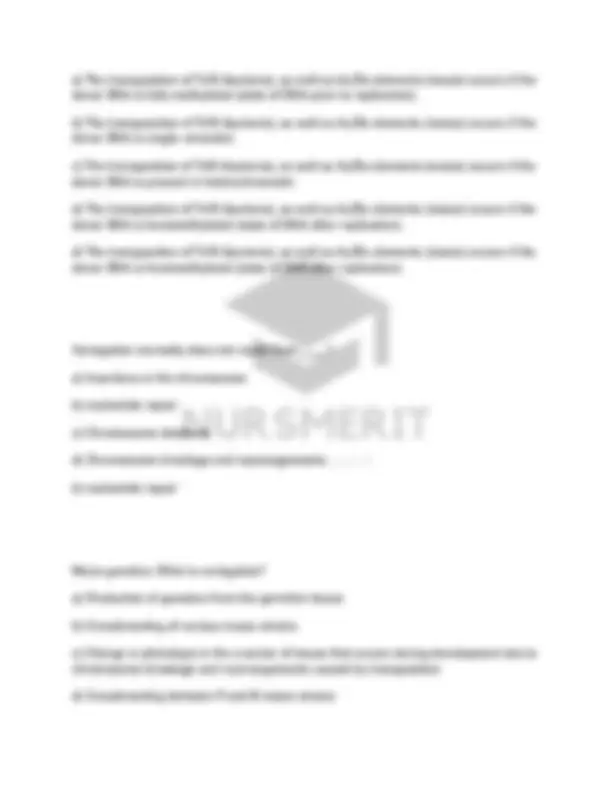
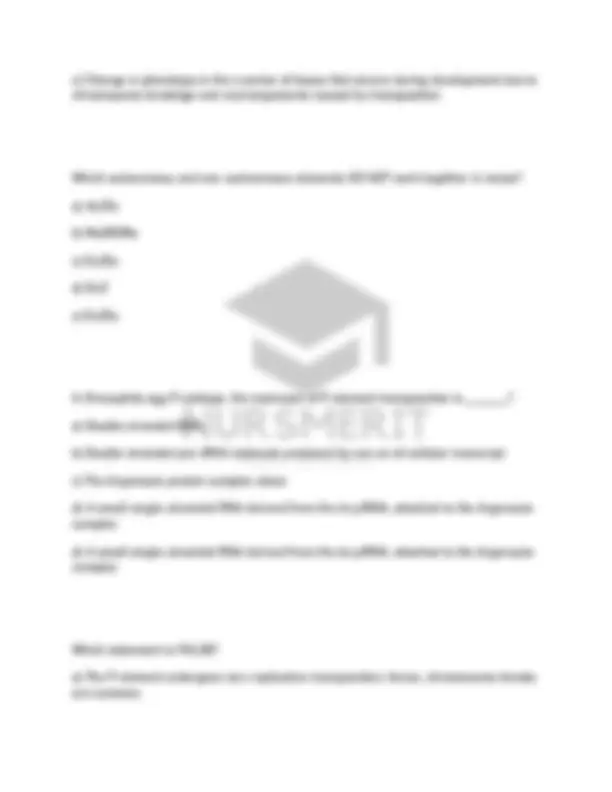
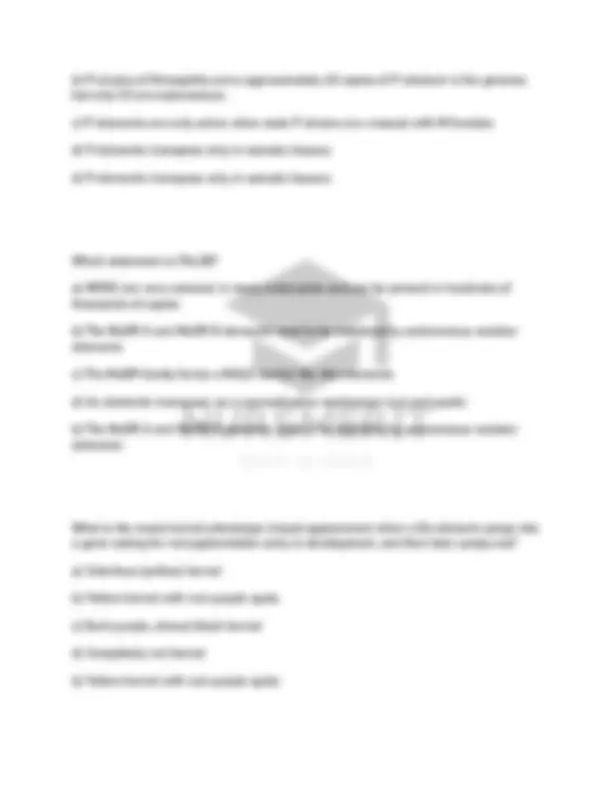
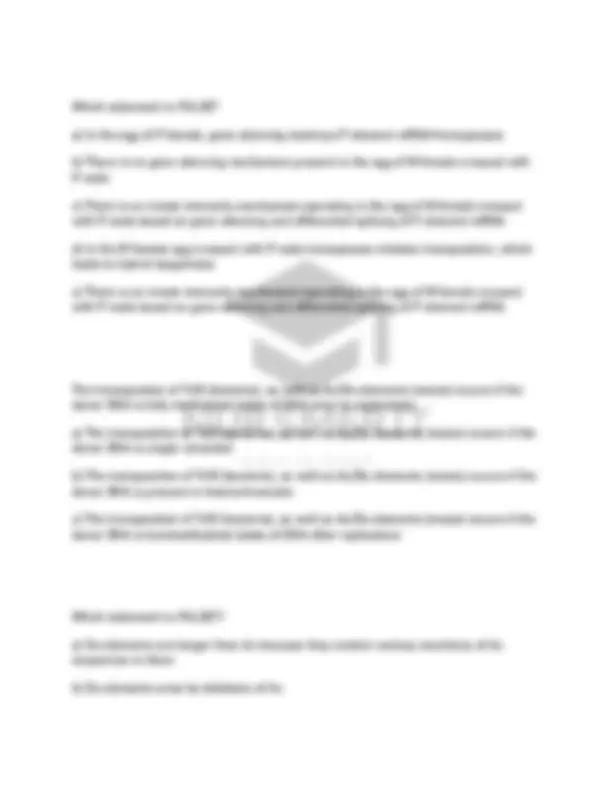
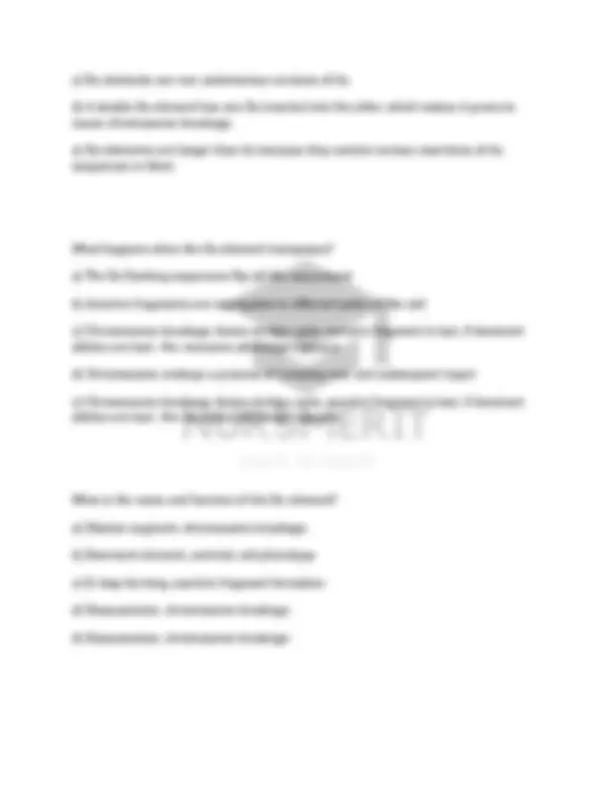
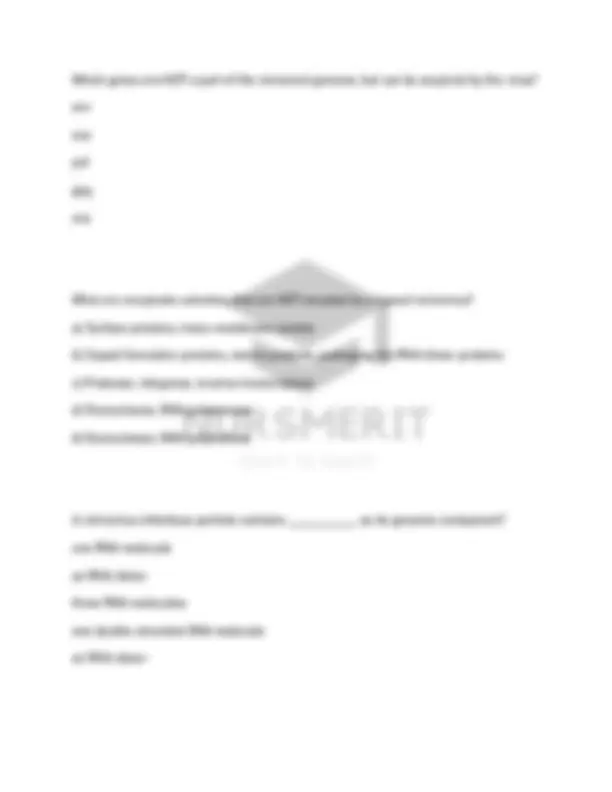
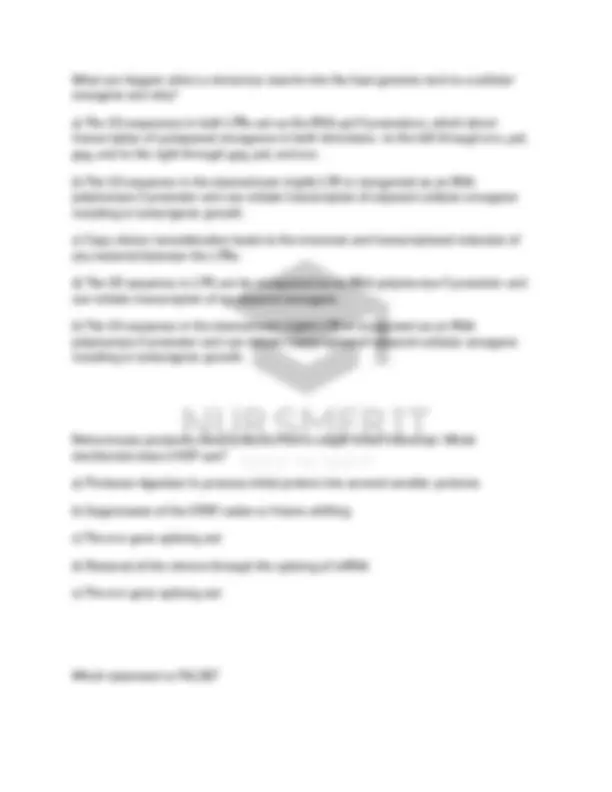
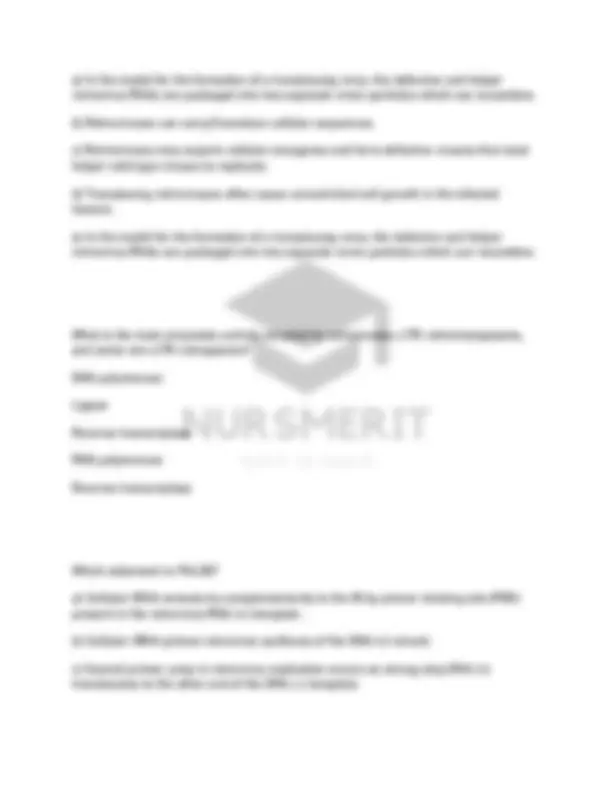

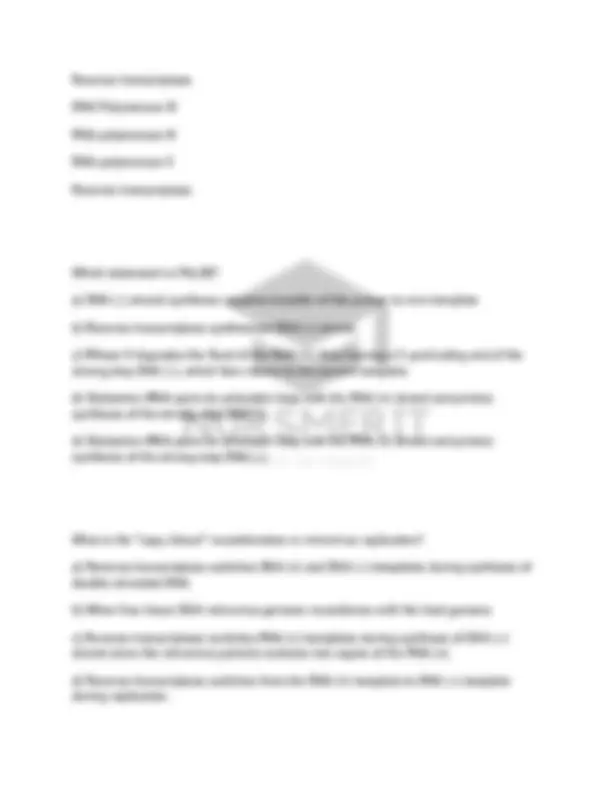

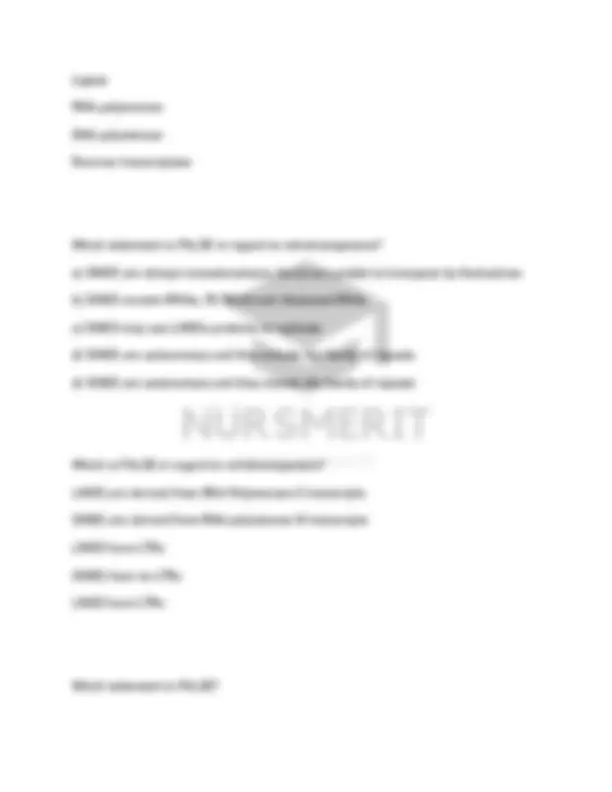
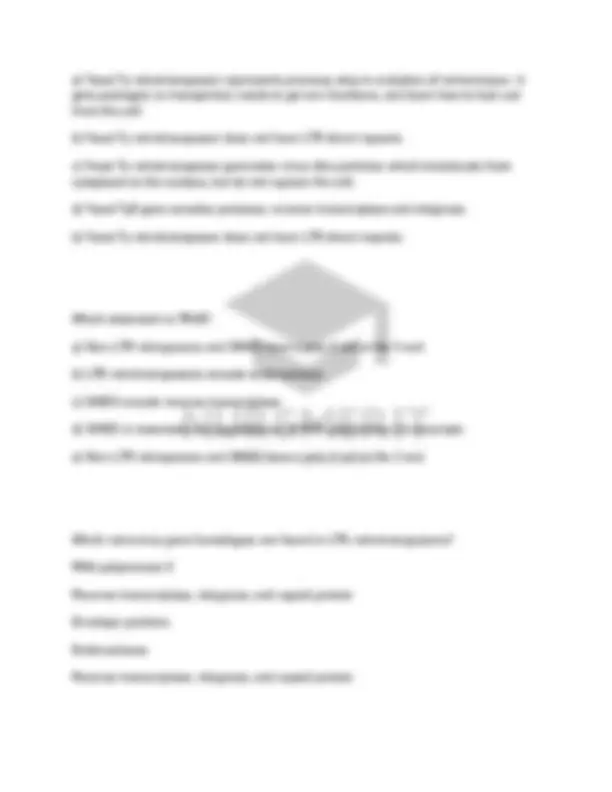
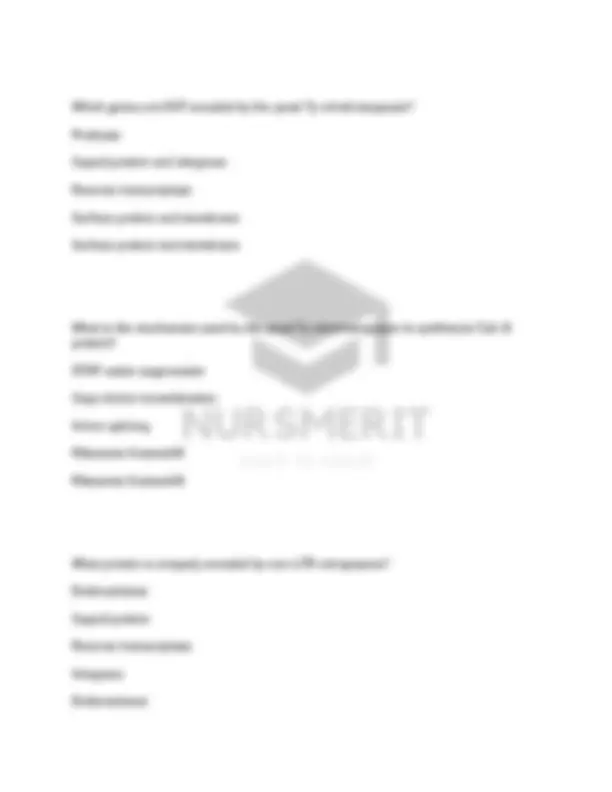



Study with the several resources on Docsity

Earn points by helping other students or get them with a premium plan


Prepare for your exams
Study with the several resources on Docsity

Earn points to download
Earn points by helping other students or get them with a premium plan
Community
Ask the community for help and clear up your study doubts
Discover the best universities in your country according to Docsity users
Free resources
Download our free guides on studying techniques, anxiety management strategies, and thesis advice from Docsity tutors
A series of multiple choice questions and answers related to dna replication, covering key concepts and processes involved in the duplication of genetic material. It provides a comprehensive overview of the mechanisms and enzymes involved in dna replication, including initiation, elongation, and termination. The questions and answers are designed to test understanding of the fundamental principles of dna replication and its significance in cellular processes.
Typology: Exams
1 / 60

This page cannot be seen from the preview
Don't miss anything!





















































How does DnaA prevent reinitiation at the oriC until the next cell cycle? a) DnaA binds to membrane phospholipids, and this inactivates its ATPase activity. b) DnaA hydrolizes ATP, and this inactivates it. c) DnaA binds ATP, and this inactivates it. d) DnaA binds single-stranded DNA, and this inactivates it. b) DnaA hydrolizes ATP, and this inactivates it. Which is FALSE? a) The palm is the most conserved domain in the DNA polymerase family. b) DNA binds in the cleft between thumb and fingers. c) DNA polymerases have a common structure of palm, fingers, thumb, exonuclease and N-terminal domains. d) The thumb domain is the most conserved in DNA. d) The thumb domain is the most conserved in DNA. DNA polymerase I Klenow fragment is NOT used for _________.
a) Nick translation b) Digesting away protruding 3'-overhangs c) DNA sequencing d) filling-in DNA at recessed 3'-ends a) Nick translation . The DNA polymerase I Klenow fragment is missing _____________activity. a) Endonuclease b) 3' to 5' exonuclease c) 5' to 3' DNA synthesis d) 5' to 3' exonuclease d) 5' to 3' exonuclease Conditional mutations in which of the following would be classified as "€œslow-stop"? a) DnaE b) SSB c) SeqA d) DnaA and DnaG d) DnaA and DnaG Bacterial DNA polymerase I does NOT have ________ activity? a) Endonuclease activity b) 5' to 3' DNA synthesis activity
c) DNA polymerase II and III d) DNA polymerase IV and I b) DNA polymerase IV and V Which helices of DNA polymerase rotate 60 degrees to recruit the incoming dNTP? a) Helices of the exonuclease domain b) O-helixes of the finger domains c) R helices of the palm domain d) H helices of the thumb domain b) O-helixes of the finger domains . Which answer is FALSE? a) DnaB propels the PhiX174 phage leading strand synthesis replication fork. b) DnaA binds to short repeated sequences at oriC. c) Six monomers of DnaC bind each hexamer of DnaB. d) DnaB is a hexameric protein that hydrolyzes ATP. a) DnaB propels the PhiX174 phage leading strand synthesis replication fork. Which activity of DNA polymerase I provides proofreading during DNA replication? a) Endonuclease activity
b) 5' to 3' DNA synthesis activity c) 3' to 5 ' exonuclease activity d) 5' to 3' exonuclease c) 3' to 5 ' exonuclease activity . Initiation at oriC requires the sequential assembly of a large protein complex. Which proteins are necessary for the creation of the replication forks at oriC? a) DnaC, HU, NF b) DnaB, gyrase, SSB, HU c) Rep, protein A, DnaE d) SeqA, VirB, VirG b) DnaB, gyrase, SSB, HU Which protein that uniquely binds oriC is functionally analogous to the eukaryotic licensing factor? a) DnaA b) DnaE c) DnaG d) DnaB a) DnaA
b) DNA polymerase C (DNA pol III, replicase) and precursors Which statement is FALSE? a) DnaA forms an oligomeric complex that melts DNA. b) A hexamer of DnaB propels the replication fork. c) SSB protein nicks DNA at the origin of replication. d) Gyrase relaxes the supercoil tension in the genome introduced by helicase (DnaB) during replication. c) SSB protein nicks DNA at the origin of replication. Conditional lethal mutants are_______in E. coli? a) mutants that function only at high temperatures b) temperature sensitive mutants of RNA polymerase gene loci c) temperature sensitive mutants of dna genes loci d) mutants that are unable to function at lower temperatures c) temperature sensitive mutants of dna genes loci Proofreading activity of bacterial DNA polymerase I resides in the __________, and for DNA polymerase III, it's in the __________ subunit? a) C-terminal domain (half) and epsilon b) N-terminal domain (half) and beta
c) C-terminal domain (half) and tau d) Central domain (half) and alpha a) C-terminal domain (half) and epsilon Proofreading activity of DNA polymerase improves fidelity of replication by a factor of _____ fold? a) 100- 500 b) Does not improve it at all. c) 1000- 5000 d) 10- 100 a) 100- 500 Which proteins have helicase activity and power replisome movement at replication forks? a) DnaA, Cdt1 and DnaB b) SeqA, HU and protein A c) DnaB, Mcm2-7 and Rep protein d) DnaG, Cdc6 and DnaE c) DnaB, Mcm2-7 and Rep protein In eukaryotic replication, DNA polymerase _______ elongates lagging strand, and DNA polymerase _________ elongates leading strand?
Which is FALSE? a) The replisome is needed to prime replication at lesions. b) Initiation of PhiX174 replication requires the primosome complex to displace SSB from the origin. c) The primosome does not exist as free complex; it assembles at the replication fork d) In the E. coli chromosome, the components of the PhiX174 primosome are used to reinitiate at lesions. The E. coli DNA polymerase III monomeric unit consists of these proteins_______? a) Theta, tau, beta, gamma, delta b) Gamma, delta, theta, chi, psi c) Alpha, epsilon, delta, tau, gamma d) Alpha, epsilon, theta, tau, beta d) Alpha, epsilon, theta, tau, beta Which is FALSE? a) The E. coli replicase DNA polymerase III is a 900 kDa complex with dimeric structure. b) The catalytic core of DNA polymerase III consists of alpha, epsilon, and theta subunits. c) DNA polymerase is tethered to DNA template strands through the proteins of the gamma-delta complex.
d) The DNA polymerase III dimerization subunit is tau. c) DNA polymerase is tethered to DNA template strands through the proteins of the gamma-delta complex. What is the function of the primosome? a) It initiates synthesis of a DNA strand. b) It elongates leading strand during synthesis. c) It elongates lagging strand during synthesis. d) It terminates DNA synthesis. a) It initiates synthesis of a DNA strand. . DNA polymerase _____ removes ________and replaces it with _______in an action that resembles_________. a) III, RNA primer, DNA, nick translation b) I, DNA primer, RNA, proofreading c) III, RNA primer, DNA, ligation d) I, RNA primer, DNA, nick translation d) I, RNA primer, DNA, nick translation Which is NOT a characteristic feature of DnaG? (Which of the following is FALSE?)
Which is NOT the function of the replisome? a) It elongates lagging strand during synthesis. b) It initiates synthesis of a DNA strand. c) It stalls at lesions during DNA synthesis. d) It elongates leading strand during synthesis. b) It initiates synthesis of a DNA strand. Which answer is FALSE? a) The primase for both PhiX174 and E. coli oriC priming is DnaG. b) The primase for both PhiX174 and E. coli oriC priming is DnaA. c) The primosome moves behind the replication fork. d) Primosome periodically initiates synthesis of the lagging strand Okazaki fragments. b) The primase for both PhiX174 and E. coli oriC priming is DnaA. Which proteins are necessary to maintain the separated strands during PhiX replication of the leading strand? a) Cdt1, VirE b) Rep, SSB c) Orc1, CDK d) SeqA, Rep
b) Rep, SSB Which proteins are ALL components of the PhiX174 primosome? a) DnaA, DnaB, PriC, dnaT, DnaE, PriA b) PriA, PriB, PriC, dnaT, DnaB, DnaG c) DnaG, DnaE, dnaT, DnaA, PriC, SSB d) PriA, PriB, PriC, dnaT, DnaB, DnaE b) PriA, PriB, PriC, dnaT, DnaB, DnaG Processivity in replication refers to_____? a) How well DNA polymerase stays associated with DNA template during replication b) How well clamp loader bumps off primase after priming DNA synthesis c) How quickly DNA polymerase proofreads during replication d) How quickly DNA polymerase terminates replication a) How well DNA polymerase stays associated with DNA template during replication Which two proteins do NOT have analogous functions in prokaryotes and eukaryotes? a) SSB and RPA b) DNA polymerase III core and DNA polymerase beta c) DNA polymerase I and FEN1 nuclease d) DnaB and Mcm2- 7
a) The FEN1 exo/endonuclease (MF1) cuts the flap=primer-overhang created by synthesis of the next Okazaki fragment b) In eukaryotes, DNA polymerase I activity removes the flap(=primer-overhang) created by synthesis of the next Okazaki fragment. c) Prokaryotic ligase and eukaryotic ligase 1 seal gaps between Okazaki fragments in DNA replication d) In eukaryotes there is no DNA polymerase that has 5 to 3 nick translation activity b) In eukaryotes, DNA polymerase I activity removes the flap(=primer-overhang) created by synthesis of the next Okazaki fragment. Which two proteins do NOT have similar functions in prokaryotes and eukaryotes? a) Beta subunit and PCNA b) Gamma-delta and RF-C c) DNA polymerase III and DNA polymerase alpha d) DnaG and DNA polymerase alpha c) DNA polymerase III and DNA polymerase alpha Which statement is FALSE? a) A clamp loader places two beta subunits onto a DNA:RNA hybrid. b) Two DNA polymerase monomeric units associate to form a dimer through interactions of the gamma-delta complex. c) Two beta subunits form a circular clamp around nucleic acid. d) One catalytic core of DNA polymerase III is associated with each template strand.
b) Two DNA polymerase monomeric units associate to form a dimer through interactions of the gamma-delta complex. What does NOT contribute directly to increased DNA polymerase III processivity? a) Tau subunits dimerization of two monomeric units of DNA polymerase III b) Displacement of gamma-delta clamp loader by DnaG c) Recruitment of DNA polymerase by beta subunits clamped on DNA-RNA hybrids at the replication fork d) Beta subunits tethering DNA Polymerase III cores to the template strands b) Displacement of gamma-delta clamp loader by DnaG Which statement is FALSE? a) DnaG associates transiently with primosome. b) DnaB activates DnaG. c) DnaB loads DnaC onto the replication fork. d) A hexamer of DnaB propels the replication fork. c) DnaB loads DnaC onto the replication fork. Which is TRUE? a) Each Okazaki fragment stops at a specific termination site. b) DNA ligase connects the 3-OH end of one Okazaki fragment to the 5 phosphate beginning of the next fragment.
a) Diplotene, diakinesis b) Leptotene, pachytene c) Leptotene, zygotene d) Zygotene, diplotene Leptotene, pachytene Which statement is FALSE? a) NHEJ is important in the V(D)J recombination of the immune system shuffling. b) NHEJ very rarely results in insertion or deletion mutations. c) Nonhomologous end joining (NHEJ) can repair ds breaks. d) NHEJ requires Ku proteins to bind the ends of the double-strand break. b) NHEJ very rarely results in insertion or deletion mutations In synaptonemal complex, which proteins make the central element? a) Zip proteins b) Microtubules c) Actins d) Cohesins Zip proteins Which statement is FALSE?
a) Branch migration expands the D-loop. b) A joint molecule is converted to the Holliday structure for resolution. c) 5-end capture happens when the D-loop has expanded across the gap and there is enough DNA for homologous pairing. d) Branch sites can only migrate in one direction. d) Branch sites can only migrate in one direction. What is the "purpose" of recombination? (Or, what benefits to the organism are gained through the process of recombination?) a) provides a way to initiate DNA synthesis b) stimulates cell division c) provides genetic diversity and repair DNA breaks d) provides means to terminate replication provides genetic diversity and repair DNA breaks Chiasmata are best visible in _______and______? a) Diplotene , dikinesis b) Zygotene, pachytene c) Pachytene, diplotene d) Leptotene, zygotene Diplotene , dikinesis